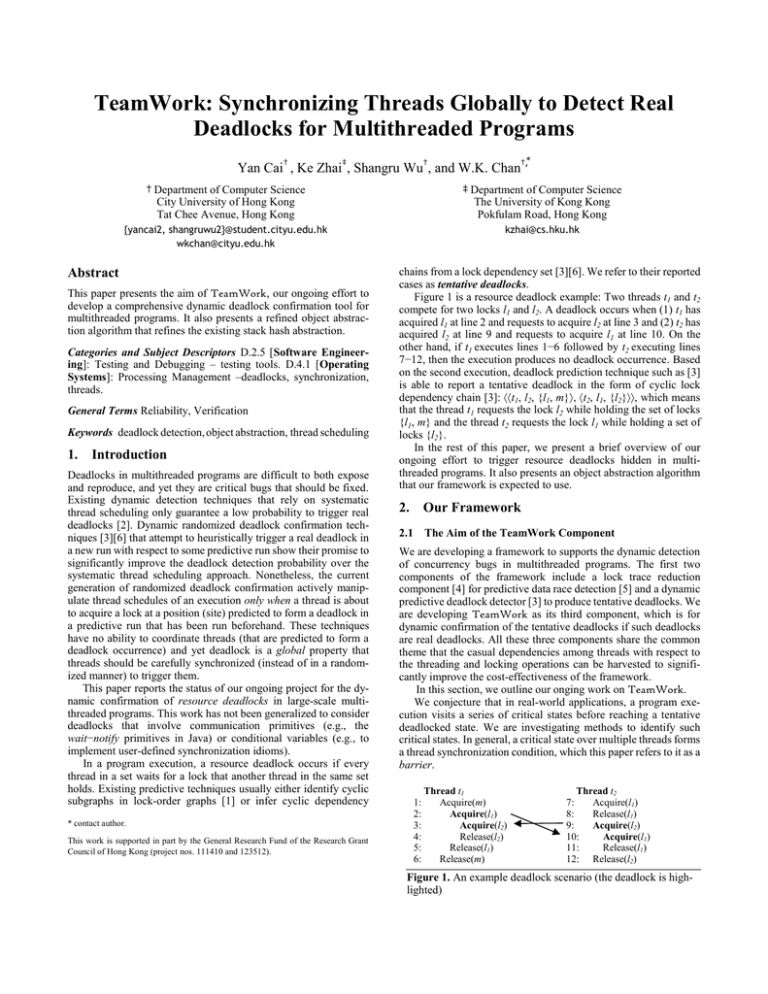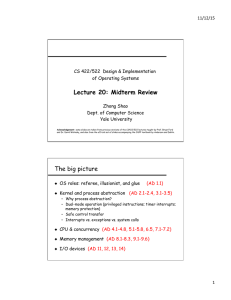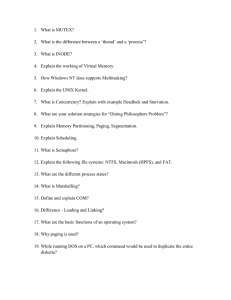TeamWork: Synchronizing Threads Globally to Detect Real Deadlocks for Multithreaded Programs
advertisement

TeamWork: Synchronizing Threads Globally to Detect Real
Deadlocks for Multithreaded Programs
Yan Cai†, Ke Zhai‡, Shangru Wu†, and W.K. Chan†, ⃰
† Department of Computer Science
City University of Hong Kong
Tat Chee Avenue, Hong Kong
‡ Department of Computer Science
The University of Kong Kong
Pokfulam Road, Hong Kong
{yancai2, shangruwu2}@student.cityu.edu.hk
wkchan@cityu.edu.hk
kzhai@cs.hku.hk
Abstract
This paper presents the aim of TeamWork, our ongoing effort to
develop a comprehensive dynamic deadlock confirmation tool for
multithreaded programs. It also presents a refined object abstraction algorithm that refines the existing stack hash abstraction.
Categories and Subject Descriptors D.2.5 [Software Engineering]: Testing and Debugging – testing tools. D.4.1 [Operating
Systems]: Processing Management –deadlocks, synchronization,
threads.
General Terms Reliability, Verification
Keywords deadlock detection, object abstraction, thread scheduling
1. Introduction
Deadlocks in multithreaded programs are difficult to both expose
and reproduce, and yet they are critical bugs that should be fixed.
Existing dynamic detection techniques that rely on systematic
thread scheduling only guarantee a low probability to trigger real
deadlocks [2]. Dynamic randomized deadlock confirmation techniques [3][6] that attempt to heuristically trigger a real deadlock in
a new run with respect to some predictive run show their promise to
significantly improve the deadlock detection probability over the
systematic thread scheduling approach. Nonetheless, the current
generation of randomized deadlock confirmation actively manipulate thread schedules of an execution only when a thread is about
to acquire a lock at a position (site) predicted to form a deadlock in
a predictive run that has been run beforehand. These techniques
have no ability to coordinate threads (that are predicted to form a
deadlock occurrence) and yet deadlock is a global property that
threads should be carefully synchronized (instead of in a randomized manner) to trigger them.
This paper reports the status of our ongoing project for the dynamic confirmation of resource deadlocks in large-scale multithreaded programs. This work has not been generalized to consider
deadlocks that involve communication primitives (e.g., the
wait−notify primitives in Java) or conditional variables (e.g., to
implement user-defined synchronization idioms).
In a program execution, a resource deadlock occurs if every
thread in a set waits for a lock that another thread in the same set
holds. Existing predictive techniques usually either identify cyclic
subgraphs in lock-order graphs [1] or infer cyclic dependency
* contact author.
This work is supported in part by the General Research Fund of the Research Grant
Council of Hong Kong (project nos. 111410 and 123512).
chains from a lock dependency set [3][6]. We refer to their reported
cases as tentative deadlocks.
Figure 1 is a resource deadlock example: Two threads t1 and t2
compete for two locks l1 and l2. A deadlock occurs when (1) t1 has
acquired l1 at line 2 and requests to acquire l2 at line 3 and (2) t2 has
acquired l2 at line 9 and requests to acquire l1 at line 10. On the
other hand, if t1 executes lines 1−6 followed by t2 executing lines
7−12, then the execution produces no deadlock occurrence. Based
on the second execution, deadlock prediction technique such as [3]
is able to report a tentative deadlock in the form of cyclic lock
dependency chain [3]: t1, l2, {l1, m}, t2, l1, {l2}, which means
that the thread t1 requests the lock l2 while holding the set of locks
{l1, m} and the thread t2 requests the lock l1 while holding a set of
locks {l2}.
In the rest of this paper, we present a brief overview of our
ongoing effort to trigger resource deadlocks hidden in multithreaded programs. It also presents an object abstraction algorithm
that our framework is expected to use.
2. Our Framework
2.1 The Aim of the TeamWork Component
We are developing a framework to supports the dynamic detection
of concurrency bugs in multithreaded programs. The first two
components of the framework include a lock trace reduction
component [4] for predictive data race detection [5] and a dynamic
predictive deadlock detector [3] to produce tentative deadlocks. We
are developing TeamWork as its third component, which is for
dynamic confirmation of the tentative deadlocks if such deadlocks
are real deadlocks. All these three components share the common
theme that the casual dependencies among threads with respect to
the threading and locking operations can be harvested to significantly improve the cost-effectiveness of the framework.
In this section, we outline our onging work on TeamWork.
We conjecture that in real-world applications, a program execution visits a series of critical states before reaching a tentative
deadlocked state. We are investigating methods to identify such
critical states. In general, a critical state over multiple threads forms
a thread synchronization condition, which this paper refers to it as a
barrier.
1:
2:
3:
4:
5:
6:
Thread t1
Acquire(m)
Acquire(l1)
Acquire(l2)
Release(l2)
Release(l1)
Release(m)
Thread t2
7:
Acquire(l1)
8:
Release(l1)
9:
Acquire(l2)
10:
Acquire(l1)
11:
Release(l1)
12: Release(l2)
Figure 1. An example deadlock scenario (the deadlock is highlighted)
Once they could be identified, we plan to synchronize selected
threads at selected barriers so that the operations performed by
these threads could be executed by stages. TeamWork aims at
escorting threads to concurrently pass through all the selected
barriers before reaching the deadlocked state. If this is successful,
TeamWork will be novel in its barrier-based strategy to confirm
real concurrency bugs in general and real deadlocks in particular.
There are some considerations that we are studying for this
component of our framework. For instance, a subset (possibly a
singleton set) of all identified barriers can be used to synchronize
threads at the same time. The same subset may be used multiple
times to manipulate the same execution before the execution
reaching the deadlocked state. Moreover, the number of threads
selected among different occurrences of the same subset (or different subsets) of all the selected barriers can be non-identical. The
thread selection strategy with respect to each barrier will be investigated. We will also study the complexity of large-scale real-world
multithreaded programs to make TeamWork both scalable and
effective to deal with this interesting class of program. As such,
TeamWork is an umbrella of techniques instead of one technique.
2.2 Object Frequency Abstraction
Our framework relies on an effective but abstract representation to
both effectively and efficiently models various entities (e.g., a
program state needed in the barriers).
For dynamic confirmation of concurrency bugs, one key challenge is to compute an object abstraction [3][6] so that a thread or
an event in a confirmation run is able to approximately map to the
“same” thread or the “same” event occurred in another (e.g., predictive) run. An exact mapping may not be able to be developed.
We have developed an instance form of object abstraction
[3][6][8] with a reference to memory indexing [7]. This form of
object abstraction used the hash value for the program stack content
(refer to as stack hash) [8] for matching efficiency. It also refines
the precision of the existing proposal [3][6] by distinguishing the
number of times that the same combination of a particular thread
(and lock) abstraction (in the sense of existing form [3][6]) and a
particular stack hash value has been used for the creation of the
abstraction. We refer to it as the object frequency abstraction:
For a lock object or a thread object o, its abstraction abs(o) is
denoted by thread_abs, call_stack_hash, newObjcounter, where
the couple call_stack_hash, newObjcounter is the site (i.e.,
site(o)) of the object.
For a lock acquisition event e, the abstraction abs(e) is denoted
by thread_abs, lock_abs, call_stack_hash, acqcounter, where
the couple call_stack_hash, acqcounter is the site (i.e., site(e))
of the event.
In the above two abstraction definitions, thread_abs is the abstraction of the thread [3] to produce the new object or lock acquisition events, lock_abs is a lock abstraction [3], and
call_stack_hash is the hash value [8] for the combination of call
stack value and a program statement stmt being executed by the
thread. Both acqcounter and newObjcounter are thread-local mappings
from thread_abs and call_stack_hash and from thread_abs,
lock_abs, and call_stack_hash to an integer, respectively. Algorithm 1 shows the algorithm to compute the object frequency
abstraction for object and locking event creations. The object
frequency abstractions for the other events and objects can be
defined and computed similarly.
In the algorithm, each call to a function getProgramCallStack (k) at lines 3 and 8 returns the sequence of the top k (inputted
at line 1) values of the program call stack (or the whole call stack if
there are less than k values). Line 2 initializes the abstraction of the
Algorithm 1: Object Frequency Abstraction
Initialization
k := input(); //a user specified value, by default, it is 8 according
//to [8].
2: abs (main_thread) := 1, 1, 1;
1:
3:
4:
5:
6:
7:
OnCreateAnObject (Thread t, Object o, Statement stmt):
Vector st := getProgramCallStack(k);
st.push (stmt);
call_stack_hash := hash(st);
newObjcounter = Occurrencecounter1 (abs(t), call_stack_hash);
abs(o) := abs(t), call_stack_hash, newObjcounter ;
OnAcquireALock (Thread t, Lock m, Statement stmt, Event e ):
Vector st := getProgramCallStack(k);
st.push (stmt);
call_stack_hash := hash(st);
acqcounter := Occurrencecounter2 (abs(t), abs(m),
call_stack_hash);
12: abs(e) := abs(t), abs(m), call_stack_hash, acqcounter
8:
9:
10:
11:
main thread (denoted by main_thread) by arbitrary values as its
abstraction. The procedure OnCreateAnObject (lines 3–7)
computes abs(o) for an object o. It firstly computes the
above-mentioned hash value, finds out the number of times that the
couple of this hash value and the thread associated with o have
previously been mapped via Occurrencecounter1() (which is a map from
the inputted pair to the occurrence times of this pair). It then constructs abs(o). The procedure OnAcquireALock (lines 8–12)
computes abs(e) for a lock acquisition event e, which can be interpreted similar to OnCreateAnObject. The function Occurrencecounter2() can be interpreted similar to Occurrencecounter1().
Using Algorithm 1, in our experimentation, the executions for
deadlock confirmation only encounters very few occurrences of
object mismatches. We leave the report of the experimental results
as a future work.
3. Conclusion
In this paper, we have presented the aim of TeamWork. We have
also presented a refined object abstraction algorithm. Future work
includes the formulation of the concrete strategy of TeamWork.
References
[1] R. Agarwal, L. Wang, and S. D. Stolle, 2005. Detecting potential dead[2]
[3]
[4]
[5]
[6]
[7]
[8]
locks with static analysis and run-time monitoring. In Proceedings of the
2005 IBM Verification Conference.
S. Burckhardt, P. Kothari, M. Musuvathi, and S. Nagarakatte, 2010. A
randomized scheduler with probabilistic guarantees of finding bugs. In
Proceedings of ASPLOS’10, 167–178.
Y. Cai and W.K. Chan, 2012. MagicFuzzer: Scalable deadlock detection
for large-scale applications. In Proceedings of ICSE'12, 606–616.
Y. Cai and W.K. Chan, to appear. Lock trace reduction for multithreaded
programs. IEEE Transactions on Parallel and Distributed Systems.
Y. Cai and W.K. Chan, 2011. LOFT: Redundant synchronization event
removal for data race detection. In Proceedings of ISSRE’11,160–169.
P. Joshi, C.S. Park, K. Sen, and M. Naik, 2009. A randomized dynamic
program analysis technique for detecting real deadlocks. In Proceedings of
PLDI’09, 110–120.
W. N. Sumner and X. Zhang, 2010. Memory indexing: Canonicalizing
addresses across executions. In Proceedings of FSE '10, 217–226.
H. Jula, D. Tralamazza, C. Zamfir, and G. Candea, 2008. Deadlock Immunity: enabling systems to defend against deadlocks. In Proceedings of
OSDI’08, 295–308.






